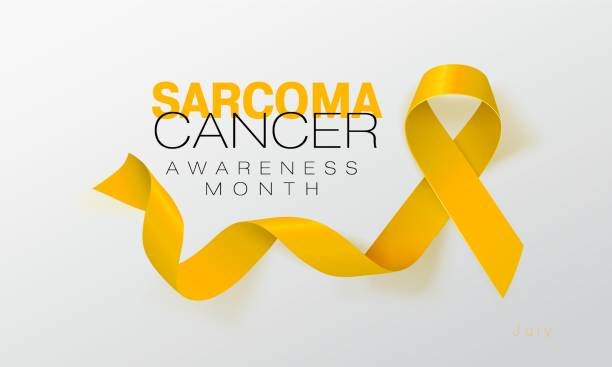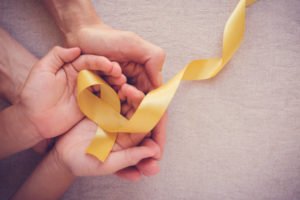
Known as the “forgotten cancer,” sarcoma is a group of diseases that starts in the bones and soft tissues but can travel to anywhere in the body. Sarcoma encompasses 70 types of cancer, and treatment depends on the location and type. July is Sarcoma Awareness Month, a time to learn more about this rare (for adults) but relentless disease not many are familiar with.
What Is Sarcoma?
Cancer forms when mutations occur in the DNA (the hereditary material) within cells. The altered DNA may signal to cells to grow and divide uncontrollably, continuing to live within the body instead of dying off. When these abnormal cells accumulate, they form a tumor. Cells within these tumors can break away and travel to other parts of the body. When a tumor is cancerous, it is called malignant. Noncancerous tumors are called benign.
In soft tissue sarcoma, tumors form in areas of connective tissue—also called soft tissue—within the body. Soft tissue includes fat, muscle, nerves, fibrous tissue, blood vessels, or deep skin tissues. Many of these tumors start forming in the arms and legs, where most of the body’s connective tissue resides. But because soft tissue is everywhere in the body, sarcoma can metastasize, traveling to other places as well, including the head, neck, trunk, internal organs, and the back.
In osteosarcomas, tumors form in the bones. They are in a separate category from soft tissue sarcomas because their characteristics are different, and they are treated differently. Osteosarcoma has a cure rate of around 70 percent.
Sarcoma accounts for only 1 percent of adult cancers but 20 percent of childhood cancers. The most common type of sarcoma in children, adolescents, and young adults is synovial sarcoma, which attacks the tissue in the joints. This type of sarcoma can travel to other parts of the body mainly through blood circulation.
Signs of Soft Tissue Sarcoma
Sarcoma may begin as a painless lump under the skin of the arm or leg—but also the chest or abdomen—with no other symptoms present. As the size of the tumor increases, it can press on nearby organs, nerves, muscles, or blood vessels. Pain and weakness develop.
Signs of sarcoma include the following:
- A lump that can be felt through the skin, which may or may not be painful
- Pain in a bone
- A broken bone that occurs unexpectedly, with or without injury
- Pain in the abdomen
- Unexpected weight loss
Risk Factors for Developing Soft Tissue Sarcoma
Several factors can increase a person’s chances of getting sarcoma, including:
- Inheritance: Some syndromes that increase the risk of cancer are passed from adults to children, including retinoblastoma (eye cancer starting in the retina) and neurofibromatosis type 1 (tumors on nerve tissues).
- Radiation therapy for cancer: People who go through radiation treatments for cancer may develop a sarcoma later on.
- Chronic swelling (lymphedema): A swelling formed by a backup of lymph fluid can increase the chances of developing angiosarcoma (cancer of the lining of blood vessels and lymph vessels).
- Chemical exposure: Certain chemicals, including herbicides and industrial chemicals, can increase your risk of sarcoma in the liver.
- Viral exposure: Certain viruses, including human herpesvirus 8, can increase the risk of developing Kaposi’s sarcoma (sarcoma that develops on the skin, in lymph nodes, in the mouth, and other organs) in people who are immunocompromised.
Diagnosing Soft Tissue Sarcoma
Typical ways to diagnose sarcoma include:
- Physical exam
- Imaging tests, including X-rays, magnetic resonance imaging (MRI), computed tomography (CT) scans, bone scans, and positron emission tomography (PET) scans
- Biopsy: Removing tissue and sending it to a lab for testing
Treatment for Sarcoma
Treatment for sarcoma will depend on the type you have, its location, how aggressive the disease is, and whether the cancer has metastasized.
Treatments may include:
- Surgery: Removing the cancer cells is the goal. This sometimes includes having to amputate a leg or arm, although surgeons will try to preserve limb function whenever this is possible.
- Radiation therapy: High-powered beans are directed into the body to kill cancer cells. Sometimes the beam comes from an external source, and other times it is placed directly in the body temporarily.
- Chemotherapy: Chemicals in drugs are used to kill cancer cells. Chemotherapy works better in some cancers than in others.
 Targeted therapy: Drugs are used to treat specific weaknesses in cancer cells.
Targeted therapy: Drugs are used to treat specific weaknesses in cancer cells.- Immunotherapy: Drugs are used to aid your immune system in fighting cancer.
- Ablation therapy: Electricity is used to heat the cells, extremely cold liquid is used to freeze the cells, or high-frequency ultrasound waves are used to damage cells.
Support
Finding support, such as through the following, is essential if you or a loved one experiences sarcoma or any other cancer:
- The American Cancer Society (ACS) offers a wealth of resources on all types of cancer, including a link to online support groups. Visit the ACS website to learn about soft tissue sarcoma, including where to find local support communities.
For information on local resources, the ACS has a dedicated page offering assistance in finding services that include Road to Recovery (free rides to treatments), advocacy, cancer information (800-227-2345), and lodging when cancer treatments are needed far from home. Visit the ACS website, for more information.
- The San Diego chapter of the ACS is located at 5333 Mission Center Road, suite 105, in San Diego. It can be reached by phone 24 hours a day, seven days a week, at 800-227-2345.
- For children with cancer and their families, Rady Children’s Hospital offers several support groups, including Some of My Best Friends Are Bald (SOMBFAB) for cancer patients and teen siblings, Families Supporting Families, the Sibling Support Group (SIBS), and others. Visit the Rady website for more information, including locations and meeting times.
- The Sarcoma Foundation of America also has a list of California treatment centers on its website, including the University of California, San Diego’s Moores Cancer Center (866-773-2703). For more information, visit the UC San Diego Health website.
Herrick Library Resources
The following books and movies featuring people with sarcoma can be checked out from Herrick Library:
- 50/50: DVD starring Joseph Gordon-Leavitt about two best friends, one of whom has schwannoma neurofibrosarcoma (rated R)
- After You Hear It’s Cancer: A Guide to Navigating the Difficult Journey Ahead, by John Leifer
- *Children with Cancer, by National Cancer Institute
- The Fault in Our Stars: DVD, starring Shailene Woodley and Ansel Elgort, about two teens with cancer, one of whom has osteosarcoma (rated PG-13)
- Soft Tissue Sarcoma, by National Comprehensive Cancer Network
Sources: American Cancer Society, What Is a Soft Tissue Sarcoma, https://www.cancer.org/cancer/soft-tissue-sarcoma/about/soft-tissue-sarcoma.html; Mayo Clinic, Sarcoma, https://www.mayoclinic.org/diseases-conditions/sarcoma/symptoms-causes/syc-20351048; National Institutes of Health, National Cancer Institute, Childhood Soft Tissue Sarcoma Treatment (PDQ)—Patient Version, https://www.cancer.gov/types/soft-tissue-sarcoma/patient/child-soft-tissue-treatment-pdq; Sarcoma Foundation of America (SFA), July Is Sarcoma Awareness Month, https://www.curesarcoma.org/sarcoma-awareness-month/; SFA What Is Sarcoma?, https://www.curesarcoma.org/patient-resources/; University of Colorado Cancer
Graphics: iStock Photo

